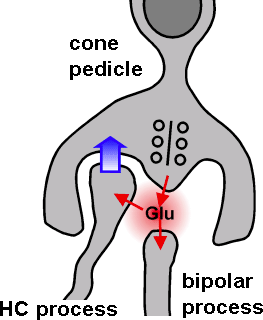Colour constancy in
fishes was shown to exist already at the retinal level, and horizontal cells
(HCs) were supposed to take part in it [1-3]. HCs collect
signals from a wide area and might supply the visual system with the information
about ambient illumination to make necessary scaling for the output cone signals
by means of some feedback mechanism.
Unlike the
feedforward version, such a scheme of discounting the illumination meets with
some difficulties when realized as a feedback circuit.
 First, the point is
that without an additional amplification in the loop the feedback fails to
fulfil good colour constancy
(see p. 5-6).
First, the point is
that without an additional amplification in the loop the feedback fails to
fulfil good colour constancy
(see p. 5-6).
Second, let us
assume that the feedback from horizontal cells does perform perfect colour
constancy in some way. Then we meet the following apparent contradiction. A perfect colour constancy means
that cone outputs (glutamate released in the cone synapse) should be already
invariant to the level of illumination. Apparently in such case HCs do not
receive any information about the illumination also and cannot provide the
necessary feedback.
The contradiction becomes even more evident in case of uniform stimulation of
the retina, when HCs responses must depend on the stimulus intensity, while the
glutamate release does not.
 First, the point is
that without an additional amplification in the loop the feedback fails to
fulfil good colour constancy
(see p. 5-6).
First, the point is
that without an additional amplification in the loop the feedback fails to
fulfil good colour constancy
(see p. 5-6).